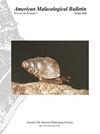The Influence of Fire and Other Environmental Factors on Terrestrial Gastropod Species Composition in an Oak-Hickory Woodland of West-Central Illinois
IF 0.4
4区 生物学
Q4 MARINE & FRESHWATER BIOLOGY
引用次数: 3
Abstract
Abstract: Terrestrial gastropods are important herbivores, prey, and as decomposers in woodlands of the Midwestern USA. Vegetation structure and composition are dynamic and may influence gastropod abundance and distribution, but relationships among gastropod communities and environmental variables are understudied. We burned three treatment units in an oak-hickory woodland during 2004 and conducted additional burns on two of those treatment units, one in 2014 and the other in 2015. In May and August 2016, we collected leaf litter containing gastropods from transects within these three burn treatment units and used 19 environmental variables that were potentially important to gastropods. Environmental variables were associated with herbaceous and woody vegetation, ground cover, physiography, and burn history. We identified 14 species of gastropods at the study site. No significant environmental models were found for gastropod abundance, richness, effective number of species (based on Shannon entropy), or effective number of species (based on the Gini-Simpson index). Statistically significant associations among gastropods and environmental variables were seen in three species. Euchemotrema leaii was associated with areas having low coverage of shrubs and other perennials, and abundant leaf litter, whereas Neohelix alleni was positively associated with leaf litter and was abundant in areas with low total cover. Glyphyalinia indentata was associated with higher elevation transects, may be impacted by recent burning, and was found in areas with greater amounts of grasses and vines.火灾和其他环境因素对伊利诺伊州中西部橡树-山核桃林地陆生腹足类物种组成的影响
摘要:陆生腹足类是美国中西部林地中重要的食草动物、猎物和分解者。植被结构和组成是动态的,可能影响腹足类的丰度和分布,但腹足类群落和环境变量之间的关系研究不足。2004年,我们在一片橡树山核桃林地烧毁了三个处理单元,并对其中两个处理单元进行了额外的焚烧,一个在2014年,另一个在2015年。2016年5月和8月,我们从这三个烧伤处理单元的样带中收集了含有腹足类的落叶,并使用了19个对腹足类可能重要的环境变量。环境变量与草本和木本植被、地面覆盖、地貌和烧伤史有关。我们在研究地点确认了14种腹足类动物。没有发现关于腹足类丰度、丰富度、有效物种数量(基于香农熵)或有效物种数量的重要环境模型(基于基尼-辛普森指数)。在三个物种中发现了腹足类与环境变量之间具有统计学意义的相关性。leaii真血吸虫与灌木和其他多年生植物覆盖率低、落叶层丰富的地区有关,而Neohelix alleni与落叶层呈正相关,在总覆盖率低的地区丰富。凹形Glyphylinia indenta与海拔较高的样带有关,可能受到最近焚烧的影响,并且在草和藤蔓较多的地区发现。
本文章由计算机程序翻译,如有差异,请以英文原文为准。
求助全文
约1分钟内获得全文
求助全文
来源期刊
CiteScore
1.00
自引率
40.00%
发文量
1
审稿时长
>12 weeks
期刊介绍:
The American Malacological Bulletin serves as an outlet for reporting notable contributions in malacological research. Manuscripts concerning any aspect of original, unpublished research,important short reports, and detailed reviews dealing with molluscs will be considered for publication. Recent issues have included AMS symposia, independent papers, research notes,and book reviews. All published research articles in this journal have undergone rigorous peer review, based on initial editor screening and anonymous reviewing by independent expertreferees. AMS symposium papers have undergone peer review by symposium organizer, symposium participants, and independent referees.

 求助内容:
求助内容: 应助结果提醒方式:
应助结果提醒方式:


